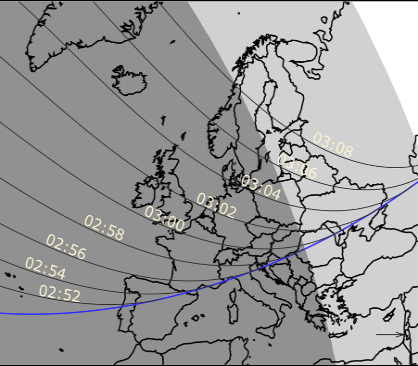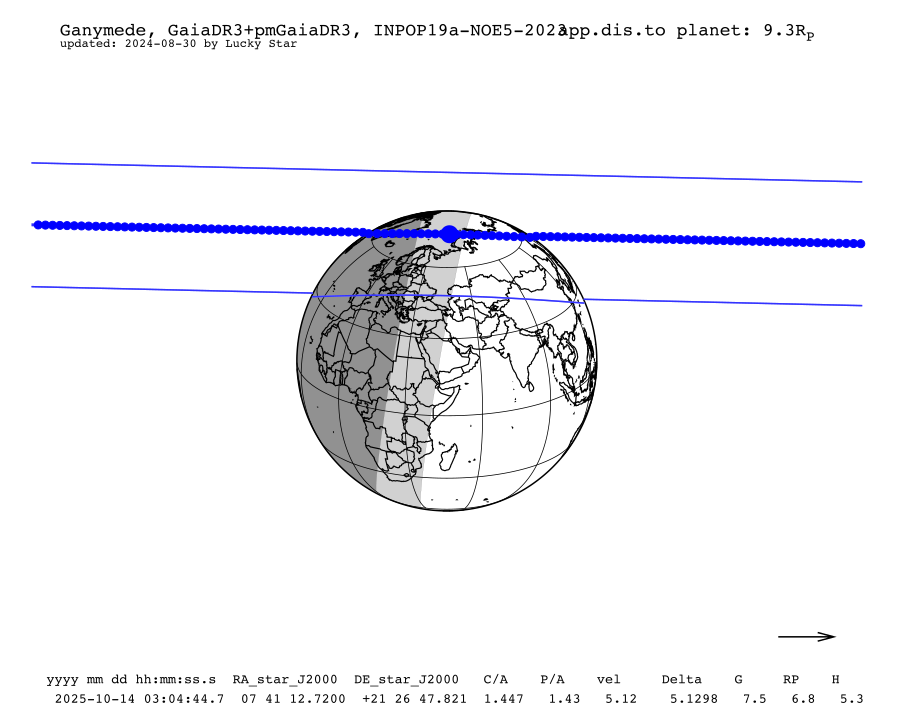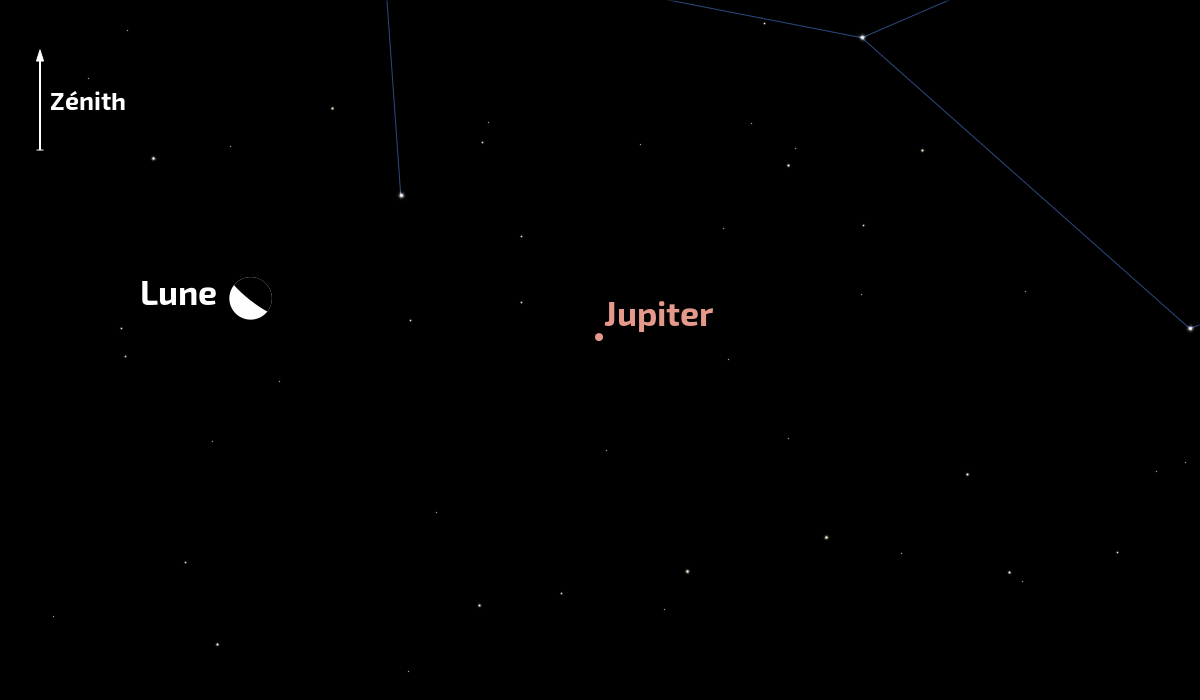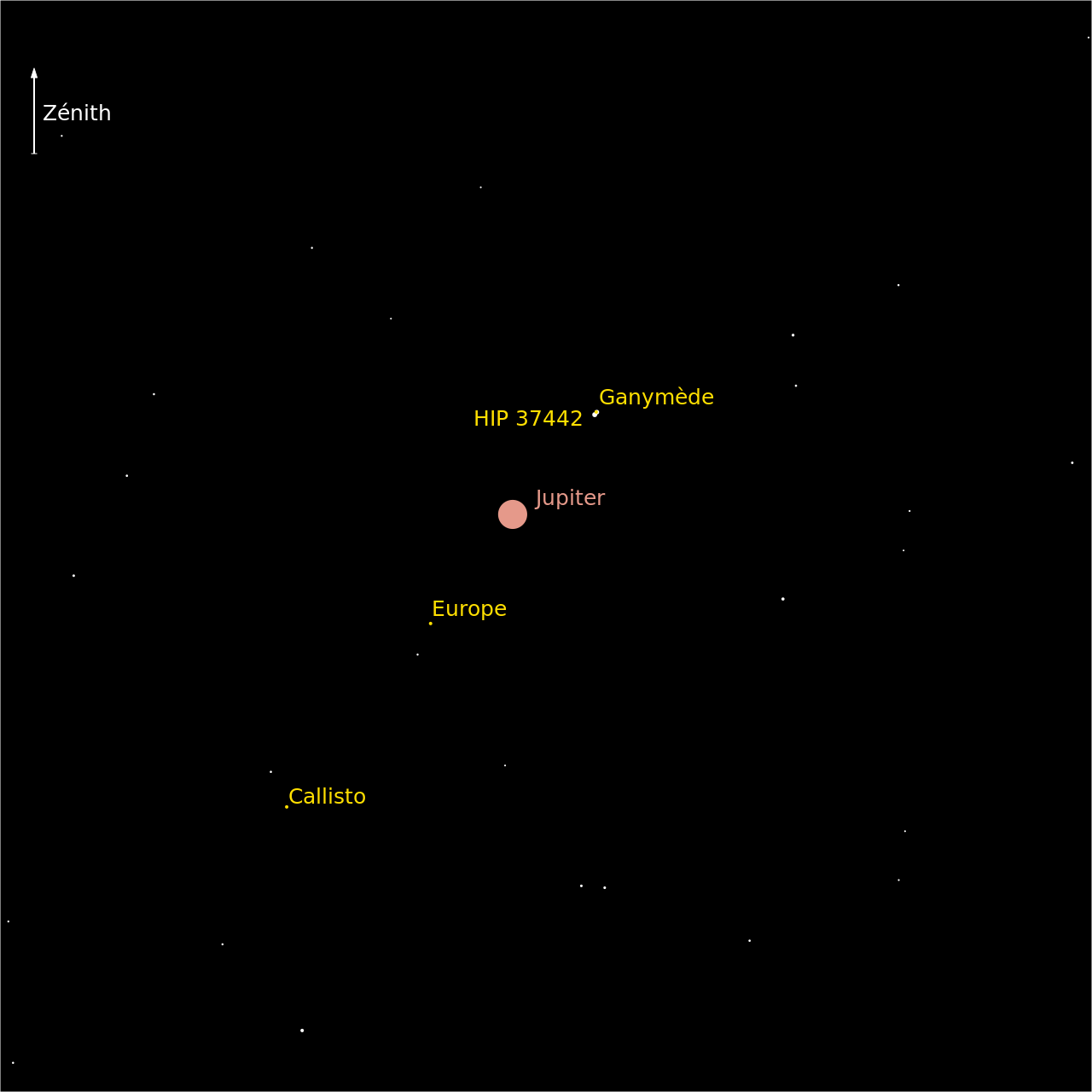The northern and southern limits of Ganymede’s shadow on Earth are determined by the two thin blue lines. The center of this shadow, marked by the thick blue line, passes close to Iceland and the Earth’s North Pole. Only the western side of the globe is still in nighttime and twilight, represented by the dark gray and light gray areas. Crédits Lucky Star
The ESA’s Juice space mission, launched on April 14, 2023, is traveling through the Solar System to reach Jupiter’s system and explore its moons starting in July 2031. The success and duration of the mission will depend, among other things, on the accuracy of the ephemerides of Jupiter’s moons.
Any observation of the occultation of the star HIP37442, whose position is known thanks to observations made by the Gaia telescope, provides valuable data that helps to specify the position of Ganymede.
Therefore, the more images we collect from your observations, the more we can improve these ephemerides and thus guarantee the success of the Juice mission.
How to observe ?
Although it is easy to observe Jupiter and its moons with a small instrument, it is unrealistic to try to follow this phenomenon with the naked eye using a telescope or binoculars. This is because the occulted star is about ten times less bright than Ganymede. It is therefore necessary to add an electronic camera to your instrument to record the images that you will transmit to the dedicated website.
What is measured during stellar occultations is the decrease in brightness caused by the occultation.
As with a total solar eclipse by the Moon, the occultation will be marked by four contacts :
- First contact : the southeast edge of Ganymede’s limb coincides with the edge of the star, marking the beginning of immersion and the partial phase of the eclipse.
- Second contact : the southeast edge of the limb completely covers the star, marking the end of immersion and the beginning of the total phase of the occultation.
- Third contact : the southwestern edge of Ganymede’s limb coincides with the edge of the star, marking the beginning of emergence and the end of the total phase.
- Fourth contact : the southwestern edge of the limb completely clears the star, marking the end of the eclipse.
You need to record the exact time of these four contacts, along with the longitude, latitude, and altitude of your observation station. The eclipse will last about ten minutes in total. You can limit yourself to recording the two sequences surrounding the immersion (first and second contacts) and then the emergence (third and fourth contacts) over a period of 2 minutes. Depending on your position, the following maps will help you determine these two sequences to be included in your two acquisition sequences.

European map with UTC isochrone curves of immersion at 2-minute intervals.
Crédits LTE

European map with UTC isochrone curves of emergence at 2-minute intervals.
Crédits LTE
From the south of France, it will be possible to observe a grazing occultation of the star by the southern edge of Ganymede. The first map in this article clearly shows that observers throughout Europe, outside the Mediterranean region, will be able to observe the same phenomenon. The differences in the observers’ positions will make it possible to reconstruct the southern edge of Ganymede and the northern edge of the star. This means that all observations are important.
How can you find Jupiter that night ? It couldn’t be easier : the Moon will catch your eye. Sky chart no. 1 shows Jupiter below and to the right of the Moon.
Sky chart for October 14, No. 1. Crédits LTE
When you find Jupiter with your instrument, you will see Ganymede alone on one side and Europa and Callisto on the other side, as shown here on sky map no. 2. Io is hidden by Jupiter during the phenomenon. Make sure you capture Ganymede and at least one other satellite (Europa) in your camera’s field of view to use as a reference. Make sure you do not saturate the signal on Jupiter’s satellites by adjusting the gain and exposure.
Sky chart for October 14, No. 2. Crédits LTE
The combined magnitude of the two objects is around 5, allowing us to operate the cameras at maximum speed. Cameras operating at 25 frames per second, 50 frames per second, 100 frames per second, or even faster will provide high-resolution information. In addition to characterizing Ganymede and the star, we will also be able to verify the accuracy of the dating and the possible latency of each observer with a high degree of precision. This is a third reason for mobilizing all occultation observers for this same event.
To go further
The occulted star HIP37442 has a G magnitude (Gaia) of 7.5 and is of spectral type K2, with a surface temperature of 4900K. Compared to the temperature of the Sun’s photosphere reflected by Ganymede, which is 5780K, it is therefore relatively weaker in the blue. It is therefore preferable to observe the phenomenon in the red (R) or near-infrared (I) to increase the contrast of the occultation. The ratio of the star’s illuminance and its luminance given by its surface temperature allows us to estimate the star’s diameter at 0.34 mas. This star was measured using optical interferometry to determine a diameter in R of 0.45 mas.
Can we measure its diameter during this occultation ?
With a speed of 5.12 km/s at a distance of 5.1298 au, we have the angular velocity of Ganymede’s apparent movement in front of the stars. This gives 1.38 mas/s (milli-arc seconds per second), so the limb will cover the star in 0.33 seconds. A video camera capable of shooting 50 frames per second will be able to record this transition in more than fifteen frames. So we will indeed be able to measure the diameter of the star. If the camera is capable of operating at a higher frame rate with a good signal-to-noise ratio, we will even be able to increase the angular accuracy. At 100Hz, for example, we can expect a resolution of 0.014 mas per frame !
We invite you to participate in the preparatory meeting we are organizing with SAF on October 4. Please find the details below.
Contacts
Josselin Desmars
josselin.desmars@obspm.fr
Raphaël Lallemand
raphael.lallemand@obspm.fr
Valéry Lainey
valery.lainey@obspm.fr
Learn more
Submit your observation data.
Participate in the October 4 meeting and in professional and amateur collaborations.
Join the Rodies, the French community of occultation observers.
Lien vers l’article.
The LuckyStar website provides details on the visibility of the occultation.





